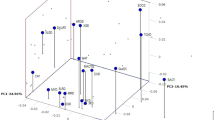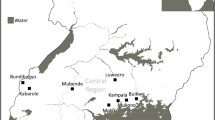Summary
The genetic affinities between the cultivated artichoke Cynara cardunculus L. var. scolym (L.) Fiori [= C. scolymus L.] and its wild relatives were assessed by tests of 20 enzyme systems (28 loci). Six representative cultivars and the following wild taxa were examined: (i) wild cardoon C.cardunculus L. var. sylvestris (Lamk) Fiori, (ii) C. syriaca Boiss., (iii) C. cornigera (Lindley) [=C. sibthorpiana Boiss.], (iv) C. algarbiensis Cosson, (v) C. baetica (Spreng.) Pau [=C. alba Boiss.], and (vi) C. humilis L. Twenty one out of the 28 loci tested were polymorphic (mainly between species). The genetic identity between the cultivars and the wild cardoon forms ranged from 0.92 to 0.96; while that between these two taxa and the five other wild Cynara species ranged between 0.67 and 0.79. This implicates wild C. cardunculus in the wild ancestry of the cultivated artichoke.
Similar content being viewed by others
References
Brown, A.H.D., E., Nevo, D., Zohary & O., Dagan, 1978. Genetic variation in natural populations of wild barley. Genetica 49: 97–108.
Crawford, D.J., 1989. Enzyme electrophoresis and plant systematics. In: D.E.Soltis & P.S.Soltis (eds) Isozymes in Plant Biology. pp. 146–164. Dioscorides Press, Portland.
DeCandolle, A. 1886. Origin of cultivated plants, 2nd ed. pp. 92–95. Retyped by Hafner, New York.
Doebly, J., 1989. Isozymic evidence and the evolution of crop plants. In: D.E.Soltis & P.S.Soltis (eds) Isozymes in Plant Biology. pp. 165–191. Dioscorides Press, Portland.
Hedrick, P.W., 1971. A new approach to measuring genetic similarity. Evolution 26: 276–280.
Murphy, R.H., J.W., Sites & C.H., Haufer, 1990. Proteins: Isozyme electrophoresis. In: D.M.Hillis & C.Moritz (Eds) Molecular Systematics. pp. 45–125. Sinaur, Sunderland.
Nei, M., 1972. Genetic distance between populations. Am. Nat. 106: 283–292.
Rottenberg, A. & D., Zohary, 1995. The wild relatives and the wild ancestry of the cultivated artichoke. Genetic Resources and Crop Evolution 43: 53–58.
Smith-Huerta, N.L., 1986. Isozymic diversity in three allotetraploid Clarkia species and their putative diploid progenitors. J. Heredity 77: 349–354.
Wendel, J.F. & N.F., Weeden, 1989. Visualization and interpretation of plant isozymes. In: D.E.Soltis & P.S.Soltis (Eds) Isozymes in Plant Biology, pp. 5–45. Dioscorides Press, Portland.
Wiklund, A., 1992. The genus Cynara L. (Asteraceae-Cardueae). Bot. J. Linnean Soc. 109: 75–123.
Author information
Authors and Affiliations
Rights and permissions
About this article
Cite this article
Rottenberg, A., Zohary, D. & Nevo, E. Isozyme relationships between cultivated artichoke and the wild relatives. Genet Resour Crop Evol 43, 59–62 (1996). https://doi.org/10.1007/BF00126941
Received:
Accepted:
Issue Date:
DOI: https://doi.org/10.1007/BF00126941




